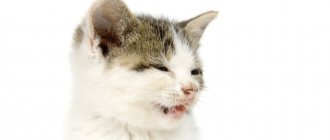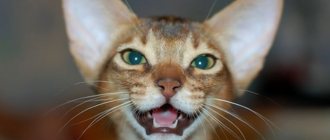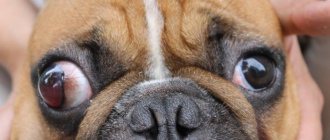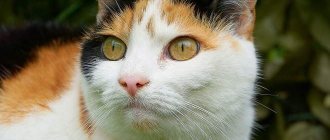For various reasons, your furry pet or cat's eyes are running . We will discuss in more detail what to do and what to do in this article, which will tell you when such a condition is normal, and when you should run to the veterinarian. This could be anything from a simple allergy to scratches that require immediate veterinary attention. A cat's eyes are a complex platform that does not tolerate experimentation.
How to examine a cat if its eyes are watery?
- As tragic as it may be, often the appearance of tears in a cat’s eyes indicates the presence of some kind of disease.
- Therefore, you need to pay attention to whether tears appeared for a short time and then disappeared, or whether the discharge in your cat’s eyes is present throughout the entire day, or worse, several days.
Tears
- If the cat’s tears are insignificant, and, having appeared in the morning, soon went away, there is nothing to worry about, and there is no reason for alarm.
- If your eyes “cry” for a long time, you should look for the cause of this phenomenon.
- When examining a cat with watery eyes, start by cleaning your hands to avoid further infection. Then try pulling down the upper eyelids on each eye .
- If the eyes are not cloudy, they shine, and the pupils are the same size, and the back surface of both eyelids is pale pink, and the cornea is transparent - everything is normal with the animal’s eyes.
Examine the animal
- If the eyelids are red or swollen, or the cornea is cloudy, this means that the cat has problems with the eyes.
- If the animal has difficulty opening its eyes or the inner surface of the eyelid is pulled up by a thin light film, it is better to visit a veterinarian as soon as possible.
Cat's eyes are watery: causes and treatment
Reasons why a cat's eyes water:
- with a foreign body in the eyes . It could be some kind of speck, fluff, twig, midge, and possibly dirt. If you find something like this, the first thing you should do is rinse the animal’s eyes under running water. Once the foreign object has been washed, apply 1% tetracycline ointment to the cat's upper eyelid . It would be a good idea to show the animal to a veterinarian.
- Weakening of the immune system . This is possible if the kitten is taken away from its mother too early. But only a veterinarian can find out whether this is so. He will also develop a regimen for taking the necessary medications and adjust the animal’s diet.
- The presence of allergies , which, just like people, are inherent in cats. Allergens can be the same as for humans: dust, chemicals, pollen, etc. Here, consultation with a specialist is also necessary, since it is unlikely that the owner himself will be able to accurately determine both the allergy itself and the cause of its occurrence.
- Worms . This is a very common cause of watery eyes in cats. To exclude such a cause, the animal should be regularly treated for worms.
- Breed cats. There are several breeds that have a characteristic skull structure with a flattened nose and deformed nasolacrimal ducts. Only daily eye rinsing and special attention to hygiene in these risky areas will help.
Prone to watery eyes - Colds . If the cat also sneezes and coughs, sleeps most of the time and absorbs a lot of water, there is reason to suspect a cold . You should not treat the animal yourself; it is better to contact a veterinarian.
- Feline distemper is accompanied, in addition to discharge from the eyes, often with pus, high fever, diarrhea and vomiting, and general weakness. Self-treatment is unacceptable.
Natural causes
There are times when cat tears are not something to be afraid of. This may be due to some temporary discomfort or peculiarity of the animal’s breed.
The cat is drooling: the main causes and treatment options
The most common causes of tearing in healthy cats are:
- waking up a cat after a long sleep;
- unsuitable diet for the animal;
- allergic reaction to household chemicals, hygiene products, medications, etc.;
- entry of a foreign body into the eye (mote, hair, fur, midge, etc.);
- breed anomaly (“Persians”, “British”, sphinxes, “Scots”, exotics, rexes have an unusual structure of the muzzle and tear duct, which does not completely remove secretions, as a result of which tears appear, and this is normal).
Important! If harder objects (glass, plastic, sand, etc.) get into the eye and injure the cornea, you should immediately consult a doctor.
What to do if a cat’s eye is leaking due to natural and non-serious reasons? She can be helped independently at home. On the one hand, such phenomena do not require professional treatment, but hygienic treatment is necessary, and for some breeds with a tendency to tear, it should be regular.
To do this, you will need anti-infective eye drops for cats (Diamond Eyes or Ophthalmosan), which can be purchased at a pet store, and a cotton pad or gauze pad. Directions for use are indicated on the packaging. Chamomile decoction is also suitable, but it is better to use a professional remedy.
After the owner instills medicine into the cat and wipes the corners of the eyes with a napkin to remove accumulated liquid, he must monitor the animal’s further health. If a cat’s eye has been running for a long time, although this anomaly does not apply to the breed, and the drops have not helped clear the corneas, the help of a specialist will be needed.
Note! Older cats and kittens may also experience tearing due to age. Eye treatment in these cases is also necessary.
Eye diseases that cause your cat's eyes to water
- Possible infection. If the eye becomes red and swollen, and pus appears, the help of a veterinarian is necessary, since feline conjunctivitis is possible.
- Direct eye disease , in particular cataracts or glaucoma . A whitened lens in the first case or a clouded cornea in the second are obvious symptoms of such diseases. Of course, treatment is only possible in a clinical setting.
- Diseases caused by viruses or fungi (such as chlamydia or toxoplasmosis) can only be treated by a specialist.
- An inflamed cornea is identified by red, watery eyes, on which a cloudy film appears.
- Entropion of the eyelid is often characteristic of Persians or, for example, sphinxes. Purulent discharge and swollen eyes are a reason to immediately visit a doctor.
- injury received if a cat got into a fight with a fellow cat, hit itself, got caught on a branch, etc. Wounds or other damage to the eyeball are symptoms of such an injury. It would be a good idea to consult a doctor to determine the severity of the injury.
From injury
You should also pay attention to the color of the discharge from the eyes.
- If the discharge is clear, similar to ordinary tears, it is most likely due to an allergy , mechanical irritation, or breed characteristics.
- If the discharge is green or yellow, mixed with pus , this indicates the presence of an infectious disease.
- If your cat's eyes are watery brown or red, it could be worms.
Why do Scottish Fold cats have watery eyes?
- As mentioned above, some cat breeds have a non-standard nasolacrimal duct, including Scottish, British, and Persian.
- Because of this, it does not completely remove the discharge, which is usually normal for any breed.
- The excess is eliminated through the eyes. If this happens after the cat has slept, then there is no need to worry, this is a normal physiological phenomenon.
Due to non-standard channel
- If your cat’s eyes are constantly watering , this is already outside the norm, and here it is necessary to find out the cause with the help of a veterinarian.
- Such cats need to wash at least once a week, and sometimes up to 2-3 times a day. If the discharge is normal, it is enough to wipe it periodically.
- If your eyes water frequently , you should contact a veterinarian and have your animal examined.
When to contact a veterinarian
First of all, the owner should pay attention to the level of severity of the phenomenon. If the cat’s eyes do not run too much and the animal’s general condition is normal, then you should first treat the visual organs yourself. If you don’t have special products at hand, you can use chamomile decoction, 0.02% furatsilin solution or boric acid solution (2 teaspoons per 0.5 cups of water) 2-3 times a day.
Red eyes in a dog: causes and what to do
After washing, you need to wait a few days until the tearing stops. If tears have been flowing for a long time, they are accompanied by purulent discharge, and the cat’s health has noticeably deteriorated, you need to immediately take your pet to the doctor or call him at home (some veterinary clinics offer such a service).
Important! If the eye injury is noticeable, then under no circumstances should you hesitate.
There are times when an allergy occurs to a new house plant or household chemical. At the same time, the cat’s eyes water, he begins to sneeze, and mucus comes out of his nose. If a cat's eye bleeds due to allergies, what should you do? Pay attention to which new strong-smelling thing the cat is often located next to. It should be removed and not used again. If you have allergies, it is better to rinse your eyes with clean water or chamomile infusion.
In any case, an urgent visit to the doctor should not be postponed; the appearance of pus, increased body temperature, refusal to eat, diarrhea, and vomiting are noticeable.
How to prevent your cat's eyes from watering?
- Of course, it would be much more correct to use hygienic methods so that the cat does not have to be treated later.
- Periodically rinse the animal's eyes with a cotton swab and warm water towards the spout.
Rinse
- If you notice dried discharge from the eye, soften it and carefully remove it, then use a clean swab to rinse the eye.
- Do not use the same tampon for both eyes, use new ones.
- If your cat's eyes are watery , do not use drops or medications without consulting a veterinarian, otherwise you may make the animal sick by using the medication incorrectly.
Treatment and prevention methods
The main methods of treating lacrimation or suppuration include the following:
- rinse both eyes of the cat with warm boiled water or a weak solution of furatsilin - several times a day as needed;
- lubricate with special ointments based on broad-spectrum antibiotics - at least twice a day;
- if there was surgical intervention - correction of entropion or eversion of the eyelids, then it is not advisable to remove the collar from the neck;
- in case of acute infections, be sure to put tetracycline ointment behind the lower eyelid and instill both eyes with chloramphenicol;
- in case of allergic reactions, give the animal hormonal or anti-allergic medications.
The duration of treatment will depend both on the pet’s immunity and the degree of development of the disease, as well as on the correctly selected procedures and medications.
It is also necessary to know that it is strictly forbidden to remove a sharp object from a cat’s eye yourself , otherwise it may negatively affect your pet’s vision. In such cases, it is necessary to urgently go to the veterinarian.
To significantly reduce the likelihood of your pet developing diseases, it is enough not to forget about the animal’s correct and nutritious diet, timely vaccination and examination at the veterinary clinic, preventive administration of anthelmintics, and compliance with basic hygiene rules.
If your cat’s health has worsened or strange behavior has appeared, contact the nearest hospital of the Aibolit Plus network of veterinary clinics. Take care of your pet’s health and don’t put off your trip until tomorrow – we will provide the necessary assistance around the clock.
A cat's eyes are watery: prevention
- If there are no problems, then for prevention you can use warm decoctions of medicinal plants intended for people (St. John’s wort, chamomile, calendula, etc.), green tea, and drops without antibiotics.
- If the veterinarian determines that the cat’s eyes are watery due to an infectious disease, use tetracycline ointment.
- For established bacterial infections, “Diamond Eyes” and their analogues are used.
Prevention measures
To prevent eye diseases, you need to follow these simple precautions:
- observe hygiene standards in the house;
- do not use strongly odorous indoor plants or household chemicals;
- deworm the animal quarterly (prevention against worms);
- Vaccinate your cat promptly;
- use high-quality feed or natural products;
- periodically treat the eyes of purebred cats that are susceptible to tearing due to the structure of the skull.
If an allergy occurs, you should wash your eyes at home only with clean water or chamomile decoction. “Diamond Eyes” drops are ideal for treating purebred cats. For severe suppuration, use furatsilin, a solution of boric acid. If there is a bruise, you should wash it with hydrogen peroxide.
Eye wash process
Important! Medicines such as tetracycline ointment, chloramphenicol, etc. are used only as prescribed by a veterinarian. You should not self-medicate.
The owner should always monitor the health of his furry pet. If a cat’s eye begins to leak, fester, and it is difficult for the animal to open it, then it is necessary to carefully examine the cornea and pay attention to the cat’s behavior. If your cat is very unwell, you should contact your veterinarian immediately.
Treatment at home is carried out mainly for breeds with a brachycephalic skull structure, since they have a shortened tear duct. Tearfulness can also be the result of an allergic reaction to dust, food, detergents, etc. Therefore, as a preventive measure, you should always keep the house clean and give your cat only high-quality food to avoid possible health problems.











